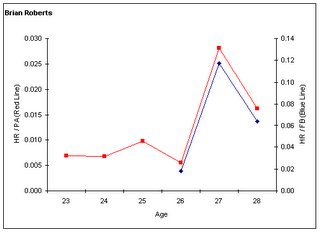The Case For The Defence
 Given what we know about the federal investigation into Barry Bonds, it's difficult to take at face value the report that Jason Grimsley gave up Brian Roberts, Jay Gibbons and Miguel Tejada as steroid users, and pitchers Roger Clemens and Andy Pettitte as users of "performance enhancing drugs" (whether they were legal under MLB rules is unstated).
Given what we know about the federal investigation into Barry Bonds, it's difficult to take at face value the report that Jason Grimsley gave up Brian Roberts, Jay Gibbons and Miguel Tejada as steroid users, and pitchers Roger Clemens and Andy Pettitte as users of "performance enhancing drugs" (whether they were legal under MLB rules is unstated).But it's not like speculation about Roberts' sudden breakout as a power-hitting second baseman is new. As the graph here illustrates, Roberts enjoyed a remarkable age-27 surge in his homerun/plate-appearance rate, and his homerun/flyball rate. However charts like this are too easily thrown around as 'evidence' that a player must be doping. There are at least four reasons why we should be skeptical:
- Age: We'd expect a good player to develop more isolated power as he entered his peak-production years.
- Experience: The start of Roberts' development was slowed by elbow surgery in 2000, and in 2001 he was quickly promoted to the major league level at age 23, where he had 273 at-bats. This was a lot to ask from a player with fewer than 600 at-bats in his professional career. Roberts' mediocre power numbers at the major league level came when he was still learning the game, fighting Jerry Hairston for a regular job, and being asked by the Baltimore organization to focus on his base-stealing skills. The spike in 2005 may look bigger than it should because the pre-2005 seasons were depressed -- and his 50 doubles in 2004 could easily be interpeted as a sign of power-in-waiting.
- Luck/Noise: That spike in power production was also accompanied by a spike in BABIP. Not shown on the graph is Roberts' BABIP for 2004-06: .316, .344, and .318. Pretty much everything went right for him in 2005 -- which is why we have the phrase "career year."
- Injury: Roberts suffered an horrific elbow injury as the end of the 2005 season. Before we interpret the 2006 drop-off in power as a sign that doping had ceased we should consider his recovery from the injury, and regression to the mean.



0 Comments:
Post a Comment
<< Home